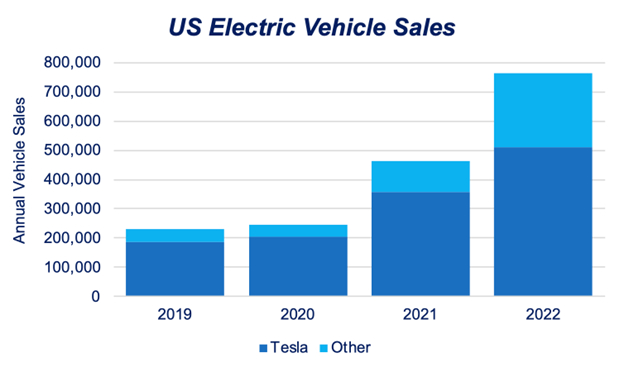Electric Vehicles
PUBLISHED 5.23.23
Q: I am seeing a lot of electric cars on the road in Lexington. Have electric vehicle sales accelerated recently?
A: Yes, there were 3 times as many fully electric vehicles sold in the US during 2022 compared to just 2 years ago. Amazingly, there were 6 times as many non-Tesla electric vehicles sold last year compared to just 2 years ago. The best-selling non-Tesla electric vehicle brands in the US are Ford, Chevy, Hyundai, Volkswagen, and Kia.
Impressively, electric vehicle sales have been growing while the US internal combustion engine (ICE) vehicle sales have been declining. US sales of ICE vehicles are down 23% over the last four years based on Kelley Blue Book numbers. The result is that about 5.5% of all vehicles sold in the US were electric in 2022 or about 1 in every 18 car sales. Massachusetts is well ahead of US averages in electric vehicle adoption, ranking 8th in electric vehicles per capita in the US.
 Bloomberg New Energy Finance recently declared that the market for internal combustion vehicles peaked in 2017 and is now in a “structural decline”. They believe that electric vehicles have reached a tipping point. If the US follows the trends in 18 other countries, they expect to see electric vehicle sales reach 25% of total vehicle sales in the next 3 or 4 years.
Bloomberg New Energy Finance recently declared that the market for internal combustion vehicles peaked in 2017 and is now in a “structural decline”. They believe that electric vehicles have reached a tipping point. If the US follows the trends in 18 other countries, they expect to see electric vehicle sales reach 25% of total vehicle sales in the next 3 or 4 years.
Q: What are some of the reasons for these trends?
A: Currently demand for electric vehicles far outstrips supply. Many car buyers are putting off buying a new car for months or even a year, while they wait for their electric vehicle to arrive.
Many people compare their first experience driving an electric car to going from a flip phone to a smart phone. Very few people who buy an electric car ever go back to driving internal combustion cars.
Electric vehicles also have much lower operating and maintenance costs, typically about half the fuel and maintenance cost of an internal combustion vehicle. Electric cars have had lower total life cycle costs than ICE vehicles for about 4 years now.
But there are other factors contributing to the overall decline of internal combustion car sales. Costs of owning a car are skyrocketing. The average monthly new car payment is $777 according to Bloomberg, and those numbers are only going up as interest rates rise.
Gen Z feels a strong ambivalence to the older generations’ car-centric culture. They are getting their driver’s licenses at far lower rates. In 1997, 43% of 16-year-olds had their driver’s licenses. Today that number is down to 25%. In 1997, 90% of 25-year-olds had licenses, now that number is down to 80%. Gen Z no longer sees a driver’s license and car ownership as the ticket to freedom. They increasingly opt for e-scooters, e-bikes and ride sharing apps. In fact, half of all ride sharing users are between the age of 18 and 29. Because Gen Z is driving less, the total amount of vehicle miles traveled per capita has also been declining since 2014.
Q: What are the current state and federal incentives for buying an electric vehicle?
A: The Massachusetts MOR-EV program provides a rebate of up to $3,500 for the purchase of a new electric car. The federal Inflation Reduction Act provides a tax credit of up to $7,500 for the purchase of a new car and up to $4,000 for the purchase of a used vehicle.
The EPA has just announced new vehicle efficiency and air pollution standards that they estimate will save American drivers $1.1 Trillion or about $9,000 to $13,000 in fuel and maintenance savings for each vehicle. They expect these standards will result in 2 out of 3 cars sold in 2032 being electric.
California and Massachusetts are planning to lead that transition, and have passed laws phasing out the sales of all new internal combustion vehicles by 2035.
Q: What do these trends mean for our health?
A: The EPA estimates that these new standards will also significantly reduce a wide range of toxic air pollution vehicle emissions, including particulate matter emissions, NOx, SO2, volatile organic compounds by 63% to 79%. An MIT study estimates that roughly 1,400 Massachusetts residents die prematurely each year from breathing particulate matter emitted from our vehicles. Internal combustion vehicles are responsible for roughly a quarter of all Massachusetts deaths from air pollution.
Electric vehicles are also significantly safer to drive than internal combustion vehicles. Electric vehicles have a low center of gravity, which significantly reduces the possibility of a rollover accident. While only 2% of crashes involve a rollover, those crashes are responsible for 35% of deaths for drivers and passengers. A Jeep Wrangler is 3 times as likely to rollover as a Tesla Model X, while a Ford Escape is twice as likely to rollover. Because electric vehicles do not have an engine in the front, EVs have dramatically larger crumple zone, which provides significantly better outcomes during head on collisions. The Insurance Institute of Highway safety reports over 40% lower injury claims for electric vehicles after a car crash. We’ll all be living a lot longer once we transition to electric vehicles.
Send your sustainability questions to questions@sustainablelexington.org.

of the Sustainable Lexington Committee
